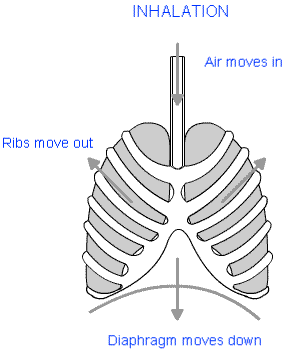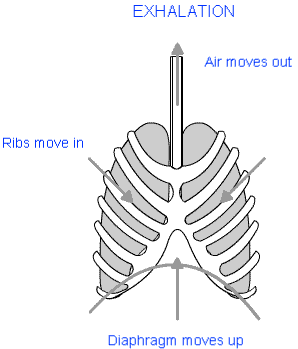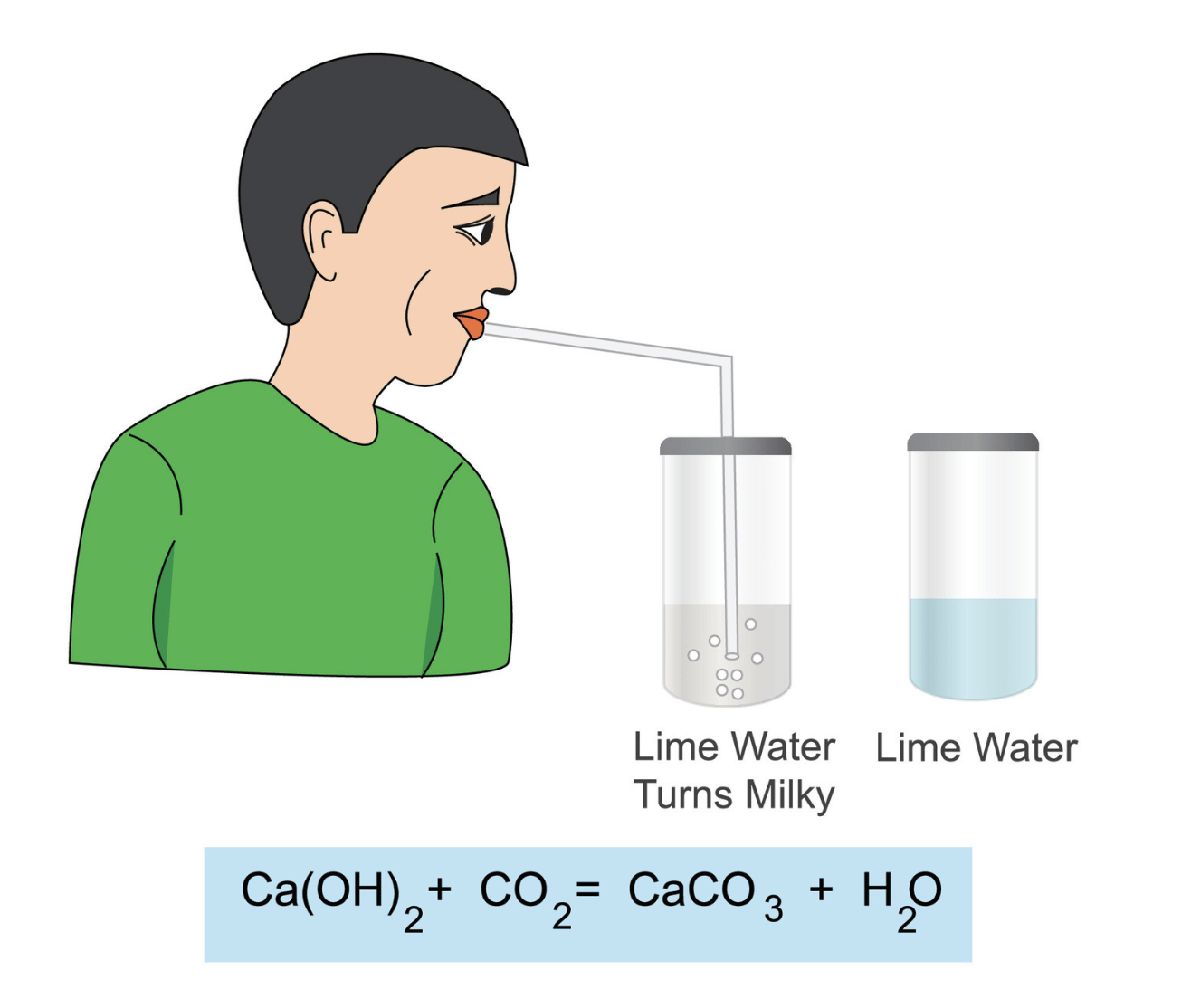Respiration in Organisms Class 7 Notes Science Chapter 6
| Table of contents |

|
| Respiration |

|
| Types of Respiration |

|
| Our Muscle Cells and Anaerobic Respiration |

|
| Breathing |

|
| Respiration in Humans |

|
| Breathing in Other Animals |

|
Respiration
Respiration
The biological process in which food(Carbohydrate) is utilized to produce energy is called respiration. Respiration is necessary for survival for the living beings. A living being cannot survive even for a few seconds, without respiration. During respiration, it is mainly the carbohydrate which is oxidized to produce energy. This can be shown by following equation:
Site of Respiration: Respiration happens inside the cells. As respiration happens inside the cell, it is also called cellular respiration. A cell organelle; called mitochondria; is the site of cellular respiration.
Types of Respiration
Types of Respiration
Types of Respiration
- Aerobic Respiration: Aerobic respiration takes place in the presence of oxygen. Carbon dioxide and water are the end products of aerobic respiration. Aerobic respiration happens in most of the organisms.
 Aerobic respiration
Aerobic respiration
- Anaerobic Respiration: Anaerobic respiration takes place in the absence of oxygen. Anaerobic respiration usually happens in most of the microbes. Alcohol and carbon dioxide are formed at the end of anaerobic respiration. In some cases, lactic acid is formed at the end of anaerobic respiration.
 Anaerobic respiration
Anaerobic respiration - Anaerobic respiration also happens in our muscle cells. When someone runs or walks too fast, one may feel a throbbing pain in calf muscles. This happens because of deposition of lactic acid; produced by anaerobic respiration. Once the person takes rest for some time, the pain goes away.
- Question for Short Notes: Respiration in OrganismsTry yourself:What is the main purpose of respiration in living beings?View Solution
Review Questions
Questions.1 What is respiration?
Answer: Respiration is a biological process in which food/carbohydrate(Glucose) is utilized to produce energy.
Questions.2 What is the end product of respiration in most of the organisms?
Answer: Carbon dioxide and water.
Questions.3 What is the end product of anaerobic respiration in muscle cells?
Answer: Lactic Acid
Yeast are single-celled organisms. they respire anaerobically and during this process yield alcohol. They are, therefore, used to make wine and beer.
Our Muscle Cells and Anaerobic Respiration
- Our muscle cells can resort to anaerobic respiration temporarily when there is a short supply of oxygen.
- During intense physical activities like fast running, cycling, prolonged walking, or heavy weight lifting, the energy demand is high while the oxygen supply is restricted.
- Under such conditions, anaerobic respiration occurs in muscle cells to meet the energy requirements.
Muscle Cramps and Anaerobic Respiration
- Have you ever pondered why muscle cramps arise after strenuous exercise? These cramps stem from muscle cells engaging in anaerobic respiration.
- During this process, glucose undergoes partial breakdown, yielding lactic acid as a byproduct.
- The accumulation of lactic acid is responsible for causing muscle cramps.
- Relief from cramps can be achieved through activities like a hot water bath or massage, which enhance blood circulation.
- Improved blood circulation leads to an increased supply of oxygen to muscle cells.
- With more oxygen available, lactic acid is completely broken down into carbon dioxide and water, alleviating the cramps.

During exercise, some muscles may respire anaerobically
Breathing
The process of taking in and giving out air; for respiration; is called breathing. Breathing involves two man steps, viz. inhalation and exhalation. During inhalation, we breathe in air which is rich in oxygen. During exhalation, we breathe out air which is rich in carbon dioxide.
Rate of Breathing
When we are doing normal activities, the rate of breathing is normal. The rate of breathing increases when we do strenuous physical works; such as running, swimming, jogging, etc. the rate of breathing decreases when we take rest or when we are sleeping.
Process of Breathing
Passage through the respiratory Tract:
- When we breathe in, air enters our body through the nostrils and travels into the nasal cavity.
- From the nasal cavity, the air moves down the windpipe and enters the lungs.
The Location of Lungs
- The lungs are situated in the chest cavity.
- This chest cavity is protected by a framework of ribs on the sides.
- The Role of Diaphragm
- At the base of the chest cavity lies a significant muscle known as the diaphragm.The diaphragm plays a crucial role in the breathing process by contracting and relaxing. When the diaphragm contracts, it flattens out, increasing the volume of the chest cavity and allowing air to rush into the lungs.

- Conversely, when the diaphragm relaxes, it returns to its domed shape, decreasing the chest cavity's volume, which forces air out of the lungs. When the diaphragm moves up, the ribcage contracts. This leads to contraction of the lungs. As a result, the air moves out of the lungs. This process is called expiration or exhalation

Breathing rate
The number of times a person breathes in a minute is termed as the breathing rate. A breath means one inhalation plus one exhalation.
Respiration in Humans
- At rest, an average adult human breathes in and out 15-18 times per minute.
- During intense physical activity, the breathing rate can escalate to 25 breaths per minute.
- Exercise prompts faster breathing along with deeper inhalation, allowing for increased oxygen intake.
- This enhanced oxygen intake is vital for meeting the body's heightened demand for energy during exertion.
- As we engage in physical activities, our body adapts to ensure sufficient oxygen is supplied to the muscles.
To show that carbon dioxide is released during exhalation:
Carbon dioxide reacts with limewater to make calcium carbonate. This property is utilized to show the evolution of carbon dioxide during respiration. For this, take a test tube and pour some limewater in it. Dip a drinking straw in the test tube. Blow air in the limewater through the drinking straw. It is observed that the limewater turns milky. This shows that carbon dioxide is released during exhalation.

Review Questions
Questions.1 What is breathing?
Answer: The process of taking in and giving out air; for respiration; is called breathing.
Questions.2 What is the respiratory organ in humans?
Answer: Lungs
Questions.3 Which membrane controls the movement of lungs?
Answer: Diaphragm
Breathing in Other Animals
Animals, which belong to amphibia, reptilian, aves and mammalia, use the lungs for breathing. Amphibians breathe through their skin, when they are in water. Smaller animals have different organs for breathing.
Breathing In Fish: Fish have a pair of gills. The breathe air; dissolved in water; through gills.
Breathing In Cockroach: Cockroach and other insects breathe through spiracles and tracheae. There is a network of hollow tubes running through the body of an insect. These hollow tubes are called trachea. Each trachea opens on the body surface in the form of very small pore. These pores are called spiracles.
Breathing In Earthworm: Earthworms breathe through their skin. The skin of earthworm always remains moist, which helps in breathing.
Breathing In Unicellular Animals: Unicellular animals breathe through the cell membrane.
Breathing In Plants: Plants can be of various sizes. Developing respiratory organs could not be a fruitful solution for plants; because of their unlimited growth. Each plant part breathes through its external layer of cells. Roots breathe through root hairs. Stems breathe through epidermis. Leaves have numerous small pores; called stomata; for breathing.
Review Questions
Questions.1 What is the respiratory organ in fish?
Answer: Gills
Questions.2 What is the respiratory organ in cockroach?
Answer: Spiracles and tracheae
Questions.3 Which organ is used by a frog for breathing under water?
Answer: Skin
|
112 videos|286 docs|28 tests
|
FAQs on Respiration in Organisms Class 7 Notes Science Chapter 6
| 1. What are the different types of respiration in organisms? |  |
| 2. How do muscle cells utilize anaerobic respiration? |  |
| 3. How does breathing play a role in respiration in humans? |  |
| 4. What is the significance of respiration in other animals besides humans? |  |
| 5. How does respiration contribute to the overall health and functioning of organisms? |  |
















